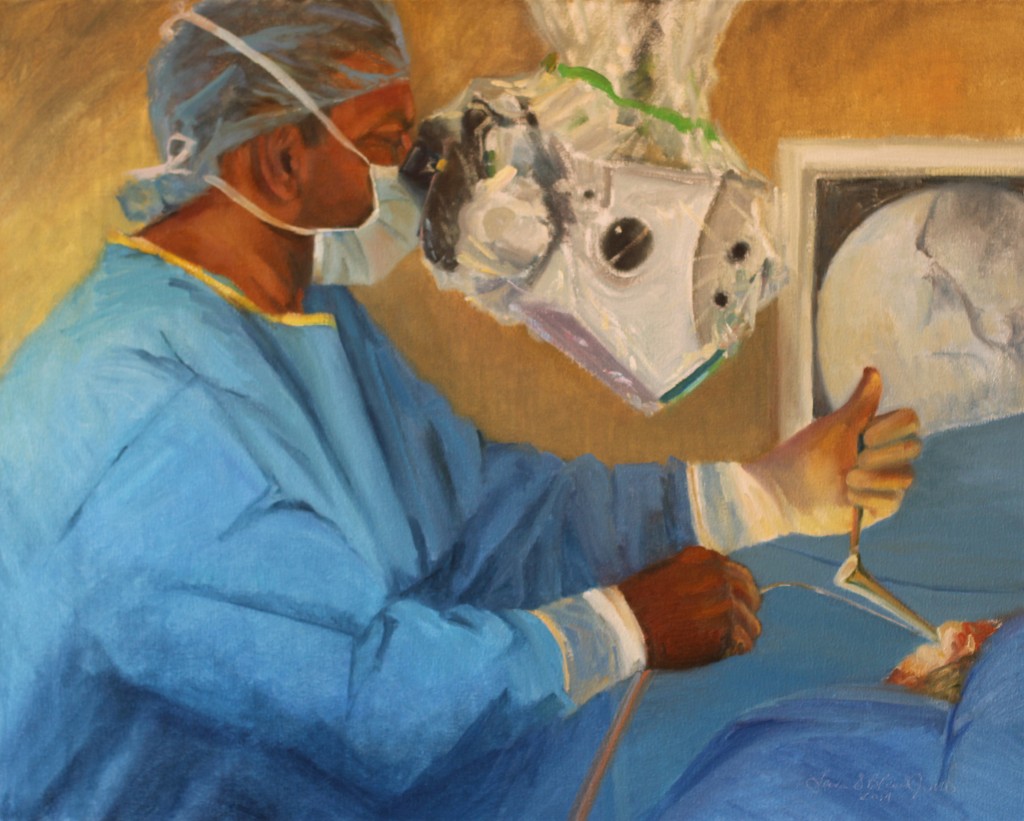Dr. Sandeep Kunwar, Surgical Director of the California Center for Pituitary Disorders at UCSF, performing a transsphenodial resection of a pituitary adenoma. Painting by Dr. Lewis Blevins.
The operating microscope, introduced by Dr. Jules Hardy many years ago, revolutionized the transsphenodial approach to resection of pituitary adenomas. The procedure used to be performed utilizing a sublabial approach, an incision of the gum at the junction of the upper lip and gum under the nose wherein the nose is then shoved upwards, but this led to significant morbidity and patient discomfort. Some surgeons, however, still use this approach. The endonasal approach, through a nostril, is now preferred. Some surgeons have abandoned the microscope and are now using the endoscope to operate on all pituitary adenomas. While this technique allows for better visualization, but truly is associated with loss of real depth perception, in some patients it is akin to using a driver to get out of a sand trap close to the green, or using a hammer to drive a screw. The endoscopic procedure is more invasive and there is greater morbidity associated with the procedure. Gimmicky things are not always better! The endoscope is the tool of choice for certain types of tumors and scenarios but should not be the tool of choice for a majority of pituitary adenomas. We will discuss this issue in the future and present the viewpoints of several physicians familiar with the different approaches to accomplishing pituitary operations.
© 2014 – 2024, admin. All rights reserved.

Is still the current thinking about microscopic vs. endoscopic surgery for pituitary adenectomy?
It’s controversial. It comes down to surgeons experience and preference. I’m convinced some endoscopic pituitary surgeons can do the procedure with very little added risk or tissue destruction. Others are less skilled and cahnge anatomy to a great degree making second operations a little more difficult. At this time, endonasal microscopic surgery is less invasive and, if it can be done, then why not!? With that said, the last two patients referred to me this week I have since referred for endoscopic surgery due to the size and extent of their tumors.
I had transphenoidal microscopic surgery performed 8 years ago by a VERY experienced neurosurgeon in NY. Significant tumor remnants remain and these have grown very slightly over the last eight years. The remnants are 8 mm from the optic nerve and extend into the cavernous sinus. I have not had radiation and if the remnants continue to grow and cause problems, I thought I might opt for endoscopic. Most say it’s the best approach (in the best hands); my own neurosurgeon says that he continues to use the microscope.
BY THE WAY, I was very impressed with your webinar on medications for hypopituitarism. I was taking 25 mg hydrocortisone (20/5) daily and asked to switch to Dexamethasone per your comments on the webinar. My endocrinologist said that he has not had sufficient experience with it and switched me to 5mg of prednisone. I do feel better on Prednisone (and have fewer afternoon “energy meltdowns,” but I was surprised by his reluctance about dexamethasone.